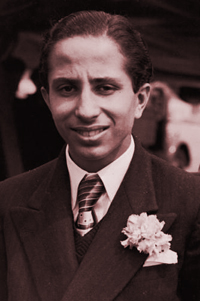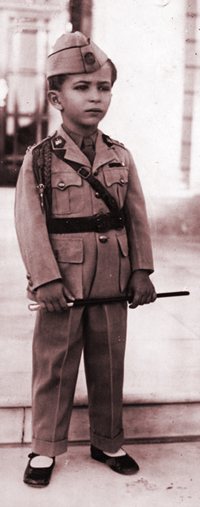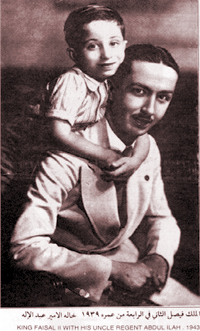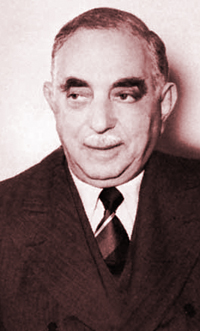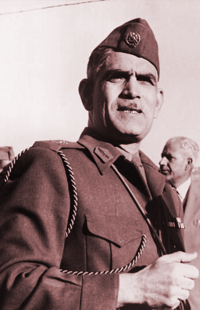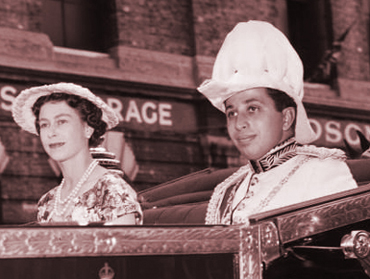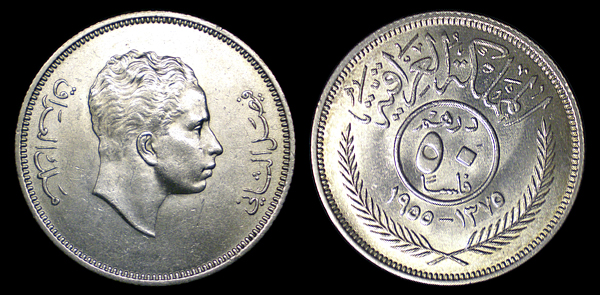
50 FILS COIN - IRAQ - KING OF IRAQ Faisal II
(KM 117)
Date: A.D. 1955
Obverse: Portrait head right - FAISAL II KING OF IRAQ
Reverse: Lettering - 50 FILS 1955 - 1375 KINGDOM OF IRAQ
Engraver: Thomas Humphrey Paget
Top Down: 1. King Ghazi in full regalia 2. As a young man in military uniform 3. As a young boy Right: Prince Ghazi with adventurer Richard Halliburton, his pilot Moye Stephens and their plane 'The Flying Carpet'
Above: Nuri as-Said, Prime Minister under Faisal II, he served under all the Kings of Iraq. Below: General Abdul Karim Qassim. |
This coin was minted for the Kingdom of Iraq (Al-Mamlaka al-Iraqiya), a large oil rich nation in south western Asia. This coin depicts Faisal bin Ghazi bin Faisal bin Hussein bin Ali, third Hashemite King of Iraq.
Born on May 2 1935 in Baghdad, he was the only son of King Ghazi and Queen Aliya. His Grandfather was Faisal I and his Great Grandfather was Hussein bin Ali, Sharif of Mecca, first King of Hejaz. He was born into the royal house of Hashim. The Hashemite are a clan within the larger Quraish tribe who claim to trace their ancestry to the family of the prophet Mohammed. The House of Hashim is a royal family founded by Hussein bin Ali, the Hashemite Sharif (religious leader) of Mecca, who had formerly ruled the Hejaz on behalf of the Ottomans. Hussein bin Ali rebelled against the collapsing Ottoman empire and proclaim himself King of Hejaz and Caliph of all Muslims in 1917, His descendants would rule Iraq and Jordan. His father King Ghazi was a staunch pan-arab nationalist. Under his rule, tensions between the civilian government and the military ended with a military coup which replaced the civilian government with a military one. The coup was supported by Ghazi who was also Admiral of the Fleet in the Royal Iraqi Navy, Field Marshal of the Royal Iraq Army and Marshal of the Royal Iraqi Air Force. This act would only embolden the military and other groups who would continue to create problems for the King and later his son. King Ghazi died in a car accident in 1939, at the age of 27, Faisal was just three years old. There were rumors of foul play, that he was killed by the ever present Nuri as-Said, a pivotal politician who served in a variety of different roles during the rule of all the Iraqi monarchs. Crown Prince Abd al-Ilah, cousin and brother-in-law of King Ghazi, was installed as regent for the young Faisal II who would be installed as King when he turned eighteen. Faisal II was well educated, first by private tutors in the royal palace, then at the Harrow School in the United Kingdom with his cousin, King Hussein of Jordan. The two young Hashemite princes became close friends, they would later become close allies and merge their two kingdoms with disastrous results. The young King was well traveled having toured Europe, the Middle East, and north Africa. He took a highly publicized tour of the United States in 1952 where he met Harry Truman and Jackie Robinson among many other well known people in business, government, sports and entertainment. On his tour of the US he made many stops visiting the Hoover Dam, San Francisco Bay, the Rocky Mountains, Laguna Beach, and Fort Knox to name a few. Under the regency of his uncle Prince Abd al-Ilah, Iraq was formally allied with the British during World War II. He was deposed briefly by former prime minister Rashid Ali al-Kaylani, who led a pro-Axis coup but was restored just a month later after the British invaded the country in May 1941. Prince Abd al-Ilah would continue to pursue a pro-west agenda, allied with Britain who retained a continued influence in Iraqi affairs through the Anglo-Iraqi Treaty of 1948. Faisal turned eighteen in 1953 and Abd al-Ilah relinquished power ending a 14 year regency. The young King found himself in a quickly deteriorating position. Although by most accounts he approached the business of state with diligence and with good intentions, he was inexperienced, out of touch with the radical changes taking place in the middle east. He relied heavily on advice from his uncle and his prime minister Nuri as-Said and signed the Baghdad Pact in 1955, continuing his uncles pro-western, pro-British policies. In 1952, King Farouk of Egypt was forced to abdicate and flee the country after a coup led by the anti-colonial, anti-monarchist, and Arab nationalist Gamal Abdel Nasser. The Egyptian revolution served as inspiration for similar movements in Iraq. In 1956, Faisal II faced uprisings in the cities of Najaf and Hayy and growing dissatisfaction with the monarchy because of its ties to western powers. Anti-western sentiment peaked with Israel's attack on Egypt with the aid of Britain and France in response to Nasser's nationalization of the Suez Canal. In 1957, a union was formed between National Democrats, Independents, Communists, and Pan-Arab nationalists such as the Ba'ath Party. Around this time, the "Supreme Committee of Free Officers" was also formed by members of the Iraqi officer corps. All with the common goal of removing the monarchy. Nasser and millions of others across the middle east and North Africa believed that the pro-western Baghdad Pact posed a threat to establishment of Arab Nationalism. On February 1, 1958, Syria joined with Egypt to form the United Arab Republic. The two young kings, Faisal II and Hussein of Jordan, joined their kingdoms just two weeks later to form the Arab Federation of Iraq and Jordon with King Faisal II as the head of state. Just Five months later, on July 14, 1958, the Iraqi army staged a coup under the command of General Abdul Karim Qassim and marched on Baghdad. Royal troops were ordered not to resist and and the king surrendered and was taken into custody by Captain Abdul Sattar Sabaa Al-Ibousi, commander of the troops ordered to take the royal palace. The captain ordered the King, his family and servants to be brought to the palace courtyard where they were told to face the wall then shot dead with machine guns. King Faisal II somehow survived the attack but died soon after. Crown Prince Abd al-Ilah, Princess Hiyam, Queen Nafissa (Abd al-Ilah's wife and mother), and Princess Abadiya (Faisal's aunt) all died in the courtyard massacre. Nuri as-Said, Faisal's Prime Minister, was butchered the following day. Faisal II was king of Iraq under his uncles regency for fourteen years and as sole ruler for five, he was 23 years old. The monarchy in Iraq was abolished and General Abdul Karim Qassim became the first Prime Minister of the New Republic of Iraq. Al-Iraq is the name used for this territory since the 6th century A.D. but Iraq was historically known as Mesopotamia, which literally means "between the rivers" and was home to the world's first civilization, the Sumerian culture, followed by the Akkadian, Babylonian, and Assyrian societies as well as being held by the Greeks, Romans, Parthians, Persians, Turks and the United Kingdom . It is often referred to as the "cradle of Civilization". Modern Iraq was formed out of three former regions held by the ottoman empire: Mosul, Baghdad and Basra. Iraq gained independence in 1932 but was then invaded and occupied again by Britain during WWII to secure it against Nazi Germany. After the war Iraq was a monarchy until 1958 when it was overthrown by the Iraqi army in what is referred to as the 14 July Revolution. After a succession of different leaders took power only to be overthrown the Arab Socialist Ba'ath Party took power. The Ba'athists key figure became Saddam Hussein who acceded to the presidency and control of the Revolutionary Command Council (RCC) on the resignation of his cousin president Ahmed Hassan al-Bakr becoming the 5th president of Iraq in July 1979, killing or imprisoning many of his opponents in the process. After international sanctions and two major conflicts stemming from Iraqi military aggression against neighboring countries, U.S. and coalition forces removed Saddam Hussein from power in 2002. They have since worked to install a democratic government that is acceptable to the various ethnic groups while attempting to rebuild a nation that was, at one time, a thriving, industrialized, progressive and wealthy Islamic nation. The new Iraqi government must now face the Insurgencies, terrorist attacks and sectarian violence that have plagued the country since the fall of Saddam. Saddam Hussein was sentenced to death by hanging and was executed on December 30, 2006. |

